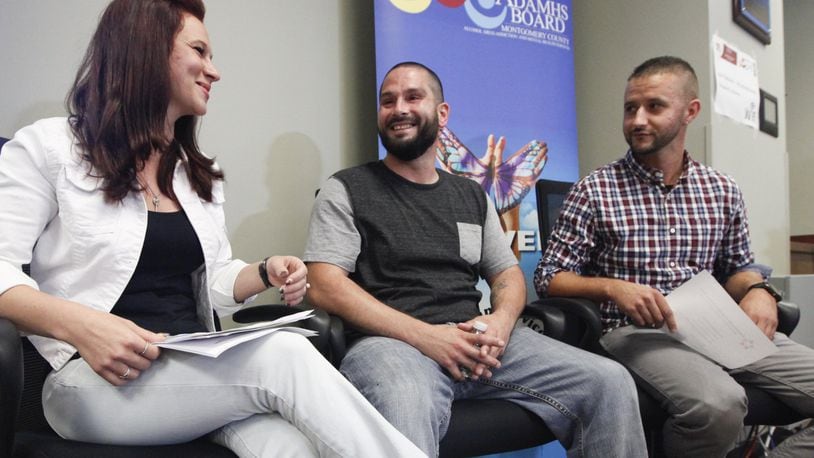RELATED: Ohio invests big in opening recovery houses for heroin addicts
Cory Kabara, 33, spent nine months in a treatment program and now credits his continued sobriety to the structure provided by a recovery house in a local neighborhood.
“Every single day of the week, we have something to do,” Kabara, a Lima native, said. “At first it can seem overwhelming, but there’s a plan behind it – learning how to deal with life in a positive way … and helping others in the process.”
MORE: 2016 deadliest year for overdoses, fentanyl deaths more than double
Recovery houses located in residential areas is a focus of faith-based organizations, nonprofits, some private citizens and the state of Ohio through county drug boards.
Joshua Recovery Ministries, where Kabara is now a house steward, operates four Dayton-area recovery houses, some of which are supported by the Montgomery County Alcohol, Drug Addiction & Mental Health Services (ADAMHS).
In all, the ADAMHS board is affiliated with seven providers operating nine local recovery houses with the ability to serve 30 women and 25 men.
“A safe place to recover is vitally important,” Helen Jones-Kelley, ADAMHS’ executive director, said. “Recovery housing relies on peer support and building a mindset and supportive network that individuals can take with them as they transition back into the community.”
Sarah Northrop-Fowler battled addiction for more than half her 31 years. During that time she divorced, lost custody of her son, served time in prison and was brought back to life twice with Narcan, the overdose reversal drug.
“I was homeless, penniless, hopeless. A truly walking, lifeless shell,” she said.
Residing in a Lighthouse Project recovery house has helped her live the last 10 months free of drugs, Northrop-Fowler said.
RELATED: Montgomery County OD crisis: ‘We are nowhere near achieving our goal’
The peer-supported arrangement is not to be confused with a group home, Jones-Kelley said. The housing is designed for those well along in their recovery to provide a safe environment supportive of abstinence and help connect residents to community services. The houses are also meant to build structure and routine and to promote life skills development aimed toward employment.
But not everyone approves of recovering addicts living next door.
A group that purchased the Branch of the Vine Church in Miamisburg for recovery housing met resistance this summer by some nearby residents. In 2016, fire engulfed a house on Berwyck Avenue in Harrison Twp. as it underwent renovations to house recovering addicts.
MORE: Drug addict recovery group’s plan for church irks Miamisburg residents
“I just ask that you be open-minded in considering the benefits that the cities and schools and our children and the once-broken homes could gain while allowing those like myself the opportunity to become clean,” Northrop-Fowler said.
Northrop-Fowler, Kabara and another man in recovery housing, Andrew Leadford, 34, all made the case for the need for recovery houses on Thursday at a Community Overdose Action Team (COAT) update to the community.
Since 2014, the Ohio Department of Mental Health & Addiction Services has invested resources to bring online more than 1,000 recovery housing beds statewide, said spokesman Eric Wandersleben.
“Expanding access to housing remains a key priority and is considered a core tenet of the long-term recovery paradigm,” said Wandersleben.
The latest biennial state budget includes more than $25 million for recovery-oriented system of care that incorporates vital supports housing, peer services and employment as part of the acute care model. In Montgomery County, about $789,000 of Human Services Levy funding is spent for recovery housing matched by federal and state funds, said Jones-Kelley.
Giving a recovering addict a place in the housing comes at a lower cost than jail, according to a 2013 state study. One report showed a per-tenant savings of $29,000 compared to not putting them in housing.
Last year, 4,050 Ohioans died from unintentional drug overdoses, according to the Ohio Department of Health. Fentanyl and extremely potent related synthetic opioids were involved in 58 percent of the deaths. In Montgomery County, 349 people died during 2016 from overdoses, 251 due to fentanyl or analogues.
“I know this epidemic is troublesome to say the least. But there’s so much hope,” Kabara said. “I’ve seen guys come into Joshua Recovery Ministries with nothing – I swear to you nothing but the clothes on their back – and they leave with the custody of their kids.”
About the Author
